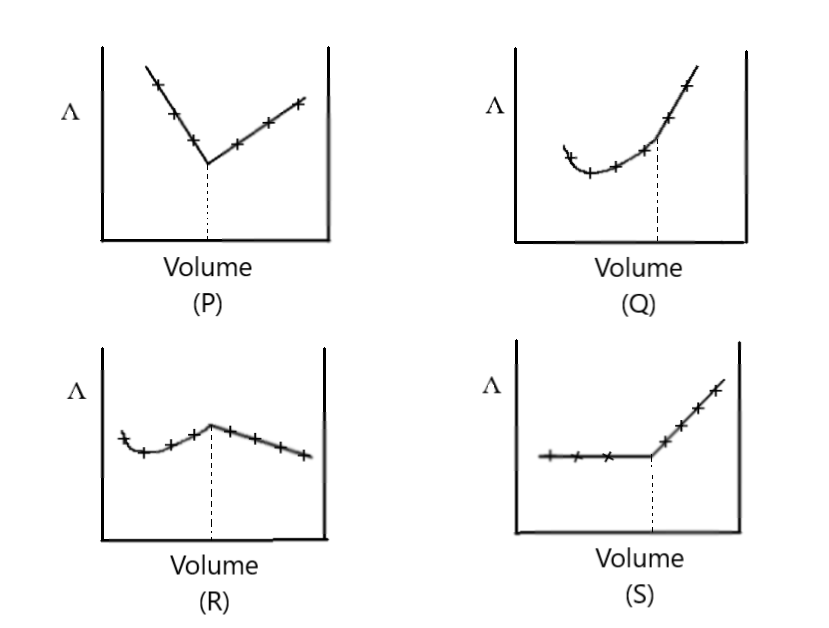
$AgN{O_3}\,\left( {aq} \right)$ was added to an aqueous $KCl$ solution gradually and the conductivity of the solution was measured. The plot of conductance ($\Lambda $) versus the volume of $AgN{O_3}$ is

A) P
B) Q
C) R
D) S

Answer
561.9k+ views
Hint: The conductivity of a solution depends upon the quantity of ions at the same time on the mobility of ions present in the solution
Usually $C{l^ - }$ and $N{O_3}^ - $ have the same mobility hence both will have the similar effect on the value of conductance
Complete step by step solution:
The reaction for this question will be
$AgN{O_3} + KCl \to KN{O_3} + AgCl \downarrow $
Initially the solution consist only of two type of ions from $KCl$ that are ${K^ + }$ and $C{l^ - }$
Now when $AgN{O_3}$ is added to this solution there will be four types of ions in the solution as follow
${K^ + },C{l^ - },A{g^ + }and\,N{O_3}^ - $
As we know that $A{g^ + }$ will react with $C{l^ - }$ to form a white precipitate of $AgCl$
Now this will reduce the amount of $C{l^ - }$ but this decrease ions will be compensated by the $N{O_3}^ - $ ions which have the same mobility as $C{l^ - }$
Now whatever the change happened in conductance value due to elimination of $C{l^ - }$ ions was compensated by $N{O_3}^ - $ ions hence the value of conductance remains constant for some time as respect to volume of $AgN{O_3}$
After some time all the $C{l^ - }$ ions will be consumed by $A{g^ + }$ for forming white precipitate of $AgCl$
And further addition of $AgN{O_3}$will increase amount of $A{g^ + }$ causing a rapid increase in the conductance value of solution
The reaction for this question will be
$AgN{O_3} + KCl \to KN{O_3} + AgCl \downarrow $
Hence, we find out that the conductivity of the solution initially remain constant but after excess addition of $AgN{O_3}$it increased rapidly
Thus, the option is “D” the correct solution for the given question.
Note:
Further the conductivity of a solution also depends upon the size of the ion, on the dielectric constant and viscosity of solvent and the temperature of the solution
The $S.I$ unit for measurement of conductance is Siemens $\left( S \right)$
Usually $C{l^ - }$ and $N{O_3}^ - $ have the same mobility hence both will have the similar effect on the value of conductance
Complete step by step solution:
The reaction for this question will be
$AgN{O_3} + KCl \to KN{O_3} + AgCl \downarrow $
Initially the solution consist only of two type of ions from $KCl$ that are ${K^ + }$ and $C{l^ - }$
Now when $AgN{O_3}$ is added to this solution there will be four types of ions in the solution as follow
${K^ + },C{l^ - },A{g^ + }and\,N{O_3}^ - $
As we know that $A{g^ + }$ will react with $C{l^ - }$ to form a white precipitate of $AgCl$
Now this will reduce the amount of $C{l^ - }$ but this decrease ions will be compensated by the $N{O_3}^ - $ ions which have the same mobility as $C{l^ - }$
Now whatever the change happened in conductance value due to elimination of $C{l^ - }$ ions was compensated by $N{O_3}^ - $ ions hence the value of conductance remains constant for some time as respect to volume of $AgN{O_3}$
After some time all the $C{l^ - }$ ions will be consumed by $A{g^ + }$ for forming white precipitate of $AgCl$
And further addition of $AgN{O_3}$will increase amount of $A{g^ + }$ causing a rapid increase in the conductance value of solution
The reaction for this question will be
$AgN{O_3} + KCl \to KN{O_3} + AgCl \downarrow $
Hence, we find out that the conductivity of the solution initially remain constant but after excess addition of $AgN{O_3}$it increased rapidly
Thus, the option is “D” the correct solution for the given question.
Note:
Further the conductivity of a solution also depends upon the size of the ion, on the dielectric constant and viscosity of solvent and the temperature of the solution
The $S.I$ unit for measurement of conductance is Siemens $\left( S \right)$
Recently Updated Pages
Why are manures considered better than fertilizers class 11 biology CBSE

Find the coordinates of the midpoint of the line segment class 11 maths CBSE

Distinguish between static friction limiting friction class 11 physics CBSE

The Chairman of the constituent Assembly was A Jawaharlal class 11 social science CBSE

The first National Commission on Labour NCL submitted class 11 social science CBSE

Number of all subshell of n + l 7 is A 4 B 5 C 6 D class 11 chemistry CBSE

Trending doubts
Differentiate between an exothermic and an endothermic class 11 chemistry CBSE

10 examples of friction in our daily life

One Metric ton is equal to kg A 10000 B 1000 C 100 class 11 physics CBSE

Difference Between Prokaryotic Cells and Eukaryotic Cells

1 Quintal is equal to a 110 kg b 10 kg c 100kg d 1000 class 11 physics CBSE

State the laws of reflection of light




